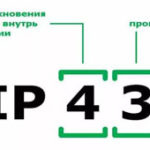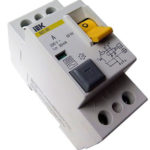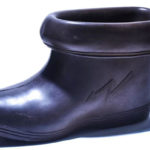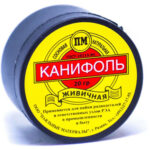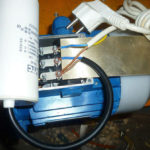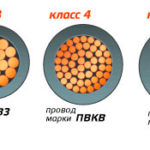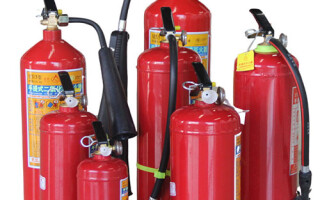The elimination of fires in houses or at technological facilities for special purposes requires compliance with certain fire safety measures and rules. Violation of these rules may result in a serious fire hazard.
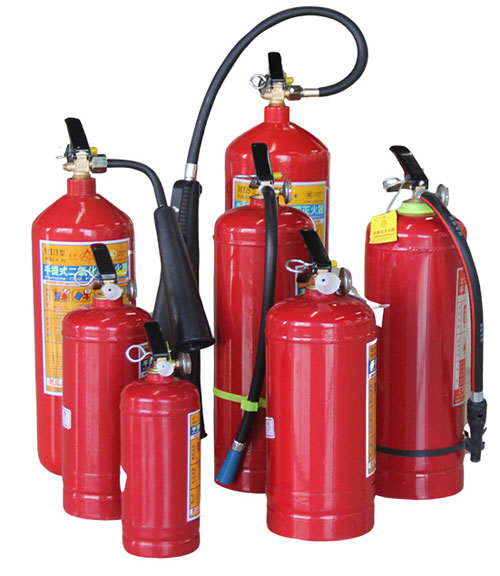
The most common causes of fires are:
- defects in wiring and electrical equipment;
- improper use of electrical appliances.
Content
Fire extinguisher selection criteria
In the event of a fire hazardous situation in rooms with electrical equipment, it is recommended to use primary fire extinguishing equipment: fire extinguishers that are easily moved from place to place and used to extinguish fires with special substances that stop burning. The main rule when choosing a fire extinguisher is the correct monitoring of a number of factors: the distinctive properties of the protected equipment, the category of the room, the volume of the protected area, the properties and mass of products subject to fire. The effectiveness of using a fire extinguisher to extinguish a fire of one class or another should also be taken into account.
The use of extinguishing agents, depending on the class of fire according to GOST 27331-87.
| Fire class | Class characteristic | Fire subclass | Subclass characteristic | Recommended extinguishing media |
|---|---|---|---|---|
| BUT | Combustion of solids | A1 | Burning of solids accompanied by smoldering (e.g. wood, paper, coal, textiles) | Water with wetting agents, foam, freons, ABCE type powders |
| A2 | Burning solids without smoldering (rubber, plastics) | All types of fire extinguishers | ||
| B | Combustion of liquid substances | IN 1 | Combustion of liquid substances insoluble in water (gasoline, petroleum products) and liquefiable solids (paraffin) | Foam, water mist, water with fluorinated surfactant, freons, CO2, powders like ABSE and ALL |
| IN 2 | Combustion of polar liquid substances soluble in water (alcohols, acetone, glycerin, etc.) | Foam based on special foam concentrates, water mist, freons, ABCE and ALL type powders | ||
| FROM | Combustion of gaseous substances | - | City gas, propane, hydrogen, ammonia, etc. | Volumetric quenching and phlegmatization with gas compositions, powders of the ABCE and ALL types, water for cooling equipment |
| D | Combustion of metals and metal-containing substances | D1 | Combustion of light metals and their alloys (aluminum, magnesium, etc.), except for alkaline | Special Powders |
| D2 | Burning alkali metals (sodium, potassium, etc.) | Special Powders | ||
| D3 | Combustion of metal-containing compounds (organometallic compounds, metal hydrides) | Special Powders |
What kind of fire extinguisher to extinguish electrical equipment
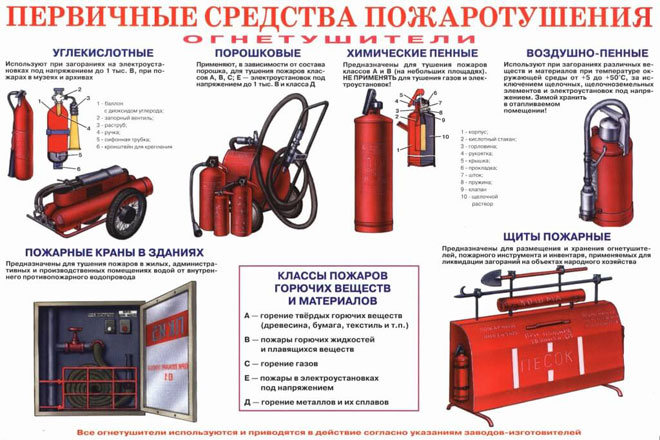
In the event of a fire, the following types of fire extinguishers are used:
Powder extinguishers
The main indicator of the operation of a powder fire extinguisher is the correct spraying of the fire extinguishing agent under pressure. The composition of the mixture includes ammonium salt, sodium and potassium salt with specialized additives. As a rule, this type of fire extinguishers is used to stop any fires. The powder mixture, when sprayed, covers and envelops the surface of the object. Air is cut off and the fire is extinguished. It is allowed to use powder fire extinguishers for class fires (A - D, see table above).
In practice, this method of extinguishing a fire is not very favored. When extinguishing valuable items, rooms in which documentation, devices, electronics are stored, this method is not recommended, since it is almost impossible to thoroughly clean the equipment.
Air Foam Fire Extinguishers
Air-type fire extinguishers are filled with a composition consisting of water and foaming additives.
When triggered, the carbon dioxide extrudes the foam solution under high pressure conditions. Further, the foaming agent in a special nozzle is mixed with air, forming foam, which cools the objects of ignition. When extinguishing, a foam film is formed that isolates the surface with an open fire from oxygen.
Air-foam type fire extinguishers are used for burning solids, flammable and flammable liquids (fire class A and B, see table above).
Carbon dioxide fire extinguishers
These fire extinguishing devices are cylinders filled with liquefied carbon dioxide (CO2). These devices are used to extinguish in cases where, during a fire, a combustible substance interacts with an oxidizing agent. The role of the oxidizing agent here is performed by the oxygen contained in the air. Use of carbon dioxide fire extinguishers is permitted for class B, C and E fires (electrical installations under voltage up to 10 kV). For substances capable of smoldering or burning without the participation of an air mixture, the use of carbon dioxide is ineffective.
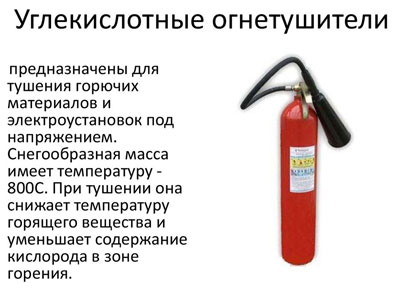
Aerosol fire extinguishers (GOA and AGS)
Extinguishing in aerosol fire extinguishers occurs either with the help of a solid filler, where the fire extinguishing aerosol is released under the influence of a flame, or with the help of a powdered fine composition. The use of GOA and AGS is very productive in case of ignition of electrical installations under voltage.
Freon fire extinguishers (marking OH)
Devices of this type are charged with a mixture of hydrocarbon derivatives, including fluorine, chlorine, and bromine substances. This is a relatively new method of extinguishing, and very effective.A serious disadvantage is that a person can stay in the room where this fluorine-containing gas is sprayed for no more than five minutes due to its toxicity. Freon fire extinguishers are successfully used in cases of ignition of electrical equipment, in server rooms, rooms with equipment, control rooms, switchboards, generator rooms.
Some features of quenching
In the event of a fire in electrical equipment, an indispensable condition is the impact on the fire source from top to bottom. The fire extinguisher must not be brought closer to a distance of 1 m from an electrical installation engulfed in flames. It is most effective to influence the fire simultaneously with several devices.
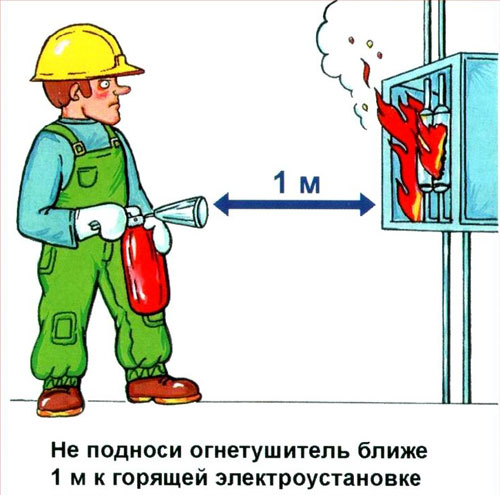
In order not to frostbite hands that are not protected by special gloves, it is not recommended to take hold of the socket of a carbon dioxide fire extinguisher, which is directed at the flame.
It is necessary to start extinguishing from the leeward side, directing a jet of the substance to the edge of the fire.
When igniting electrical installations under voltage, it is necessary to use aerosol fire extinguishers.
In case of fire in technological premises for the placement of electrical equipment - server, hardware, switchboard, it is necessary to use freon fire extinguishers.
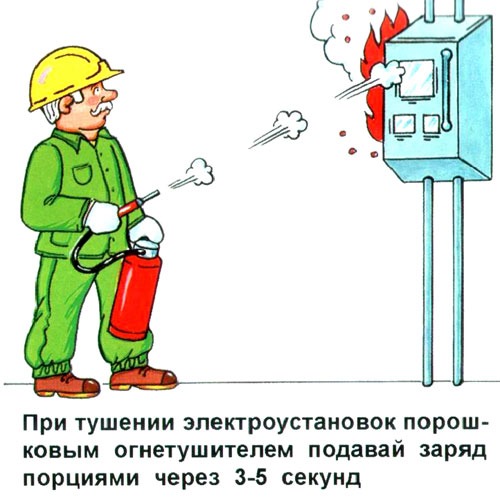
Extinguishing electrical wiring
When an electrical contact occurs between the points of an electrical circuit with different potentials (short circuit) may start a fire.
Attention! Do not extinguish electrical wiring with water! This is strictly prohibited, as you can get an electric shock.
When a flame appears, first of all, it is urgent to turn off the electricity on the shield.If the network is de-energized, then you can use any available fire extinguishing agents that are at hand - water, sand or a fire extinguisher. To eliminate ignition in electrical installations, powder and aerosol extinguishing agents are applicable (see above). When an open flame appears, it is necessary to turn off the electricity on the shield. If this is not possible, immediately call the fire brigade.
Extinguishing household electrical appliances
According to the set of rules SP 9.13130.2009 It is necessary to use fire extinguishing agents in case of ignition of household electrical appliances.
- Powder-filled fire extinguishers are allowed to extinguish electrical equipment up to 1000 volts.
- Carbon dioxide fire extinguishers are allowed to extinguish electrical installations under voltage up to 10,000 volts (10 kV).
- It is strictly forbidden to use carbon dioxide agents for extinguishing electrical equipment with a voltage higher than 1 kV with a fire extinguishing composition jet length of less than 3 meters.
Extinguishing in the electrical room
An electrical room is usually a separate room with a switchboard or cabinet located in it. This is the starting point for supplying electricity to the building.
When designing fire extinguishing in an electrical switchboard, they are guided by the set of rules SP 5.13130.2009 and choose a gas (AUGP) or powder automatic fire extinguishing installation (AUPT). Water fire extinguishing (sprinklers, drenchers) is not used in the server room.
Gas fire extinguishing installations (AUGP) are used depending on:
- on the method of quenching: volumetric quenching or local;
- from the method of storage of gaseous fire extinguishing agent: centralized, modular;
- from the method of switching on from the starting impulse: with electric, pneumatic, mechanical start.
The advantage of this method is that the compositions used in gas fire extinguishing installations do not emit toxic fumes upon contact with burning surfaces.

Gas fire extinguishing modules (MGF) can be located both in the protected room itself and outside it on a special rack. The modular gas fire extinguishing installation consists of cylinders selected according to the calculation with shut-off and starting devices (ZPU), wiring with sprayers (nozzles), a pipeline, and valves.
Extinguishing gas effectively extinguishes fires in a volumetric manner and easily penetrates into various areas of the object, where the supply of other substances that stop combustion is difficult. After the fire is extinguished or unauthorized start-up, the gas fire extinguishing agent (GOTV) has practically no harmful effect on the protected values compared to other fire extinguishing agents - water, foam, powder and aerosol, and is easily removed by ventilation.
Carbon dioxide (CO2) or freon is traditionally used to protect industrial facilities (diesel, flammable liquids, compressors, etc.).
Nozzles through which gas is released must be placed in the room, taking into account the peculiarities of its location and ensure uniform distribution of the gas mixture throughout the volume. Therefore, the necessary hydraulic calculation is carried out. The difference in the flow rate of the gaseous substance between the two extreme nozzles on the same distribution pipeline should not be more than 20%, otherwise the gas will come out unevenly and the extinguishing will not occur.
Automatic powder fire extinguishing installations (AUPP) are used to eliminate fires of classes A, B, C and electrical equipment (electrical installations under voltage).
Depending on the design of the powder fire extinguishing module, systems may or may not have a distribution pipeline. According to the method of gas storage in the module, which displaces the powder when the trigger mechanism is triggered, the installations are divided into injection, with a gas generating element, with a cylinder of compressed or liquefied gas.
For the calculated area of local fire extinguishing, the size of the protected area increased by 10%, the size of the protected volume increased by 15% is taken. When calculating the number of modules, the calculation is made from the condition of ensuring uniform filling of the volume with a powder mixture.
It was already mentioned earlier that, based on practical considerations, designers are in no hurry to apply the AUPP system. The switchboard or server room equipment can be hopelessly damaged.
Extinguishing electrical installations depending on power
When extinguishing fires in electrical installations, depending on the different voltages, different types of fire extinguishers are used.
400 Volts (0.4 kV)
Powder, carbon dioxide, freon, water and foam fire extinguishers (the last two when disconnected from the mains).
1000 Volts (up to 1 kV)
Powder and carbon dioxide fire extinguishers.
10000 Volts (up to 10 kV)
Carbon dioxide fire extinguishers.
What is forbidden to extinguish electrical equipment
What kind of fire extinguisher can not extinguish electrical equipment and electrical wiring under voltage? What rules must be observed in the event of a fire in electrical devices?
Powder fire extinguishers are prohibited to extinguish electrical equipment that is energized above 1000 V.
Air-foam fire extinguishers are not used to extinguish fires of electrical equipment under voltage.
Carbon dioxide fire extinguishers are ineffective for extinguishing fires in electrical equipment energized above 10 kV.
It is strictly forbidden to extinguish live electrical wiring with foam and water compositions, including sea water.
A fairly common cause of fires in electrical installations is a violation of the requirements of current regulatory documents on fire safety. First of all, it is careless handling of fire. The cause of the fire may be smoking in an unspecified place, improper maintenance of electrical appliances. In order to control the maintenance personnel of technological installations, periodic testing of knowledge on fire safety issues is carried out, and explanatory work is carried out with the population.
Similar articles:
